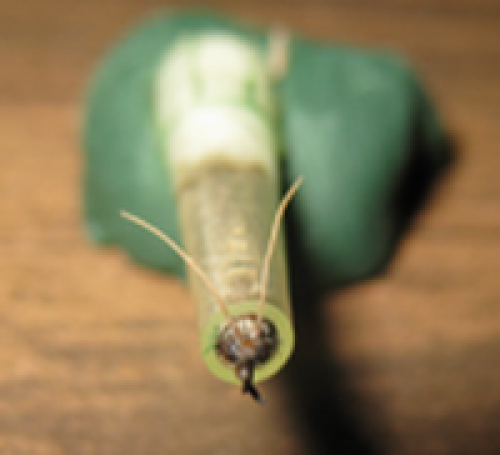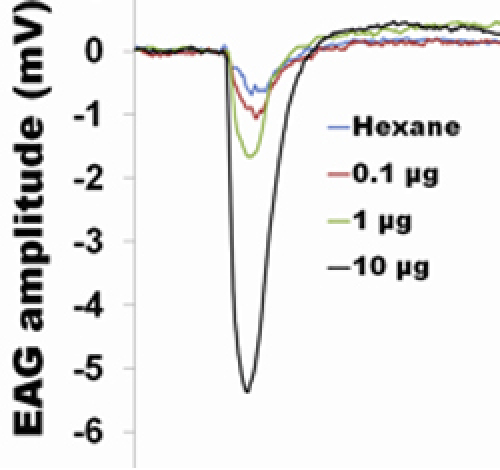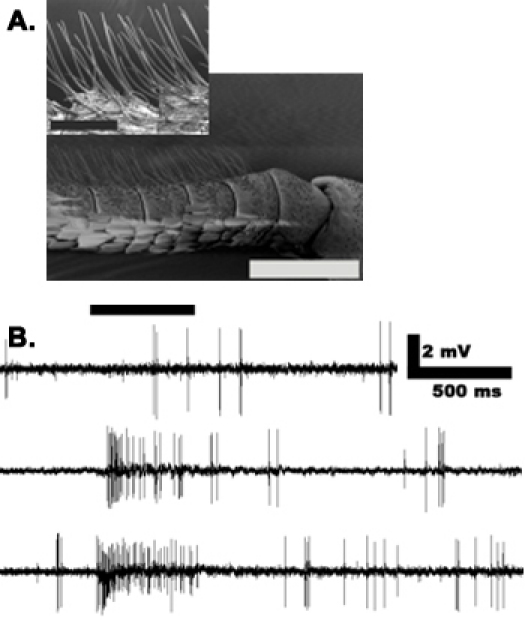Abstract
Insect olfactory systems provide unique opportunities for recording odorant-induced responses in the forms of electroantennograms (EAG) and single sensillum recordings (SSR), which are summed responses from all odorant receptor neurons (ORNs) located on the antenna and from those housed in individual sensilla, respectively. These approaches have been exploited for getting a better understanding of insect chemical communication. The identified stimuli can then be used as either attractants or repellents in management strategies for insect pests.
Protocol
1. Insects
Navel orangeworm, Amyelois transitella (Walker) (Lepidoptera:Pyralidae) colony in our laboratory originated from moths collected from almond trees in Fresno, CA. Our insects colony is maintained in environmental chambers (Percival Inc, IA ) at 28 ± 2°C, 75 ± 10% relative humidity, and under 16:8h (light:dark) photo regime.
Emerging moths are collected daily, sexed, and transferred to plastic boxes (669 mL lunchbox,13 x 13 cm; height, 4.5 cm, Rubbermaid) provided with up to 10 layers of water soaked paper towels (Thirsty Ultra Absorbent, 27.9 x 27.9 cm; Safeway). Box covers are perforated to allow air circulation. This arrangement provides ~100% RH.
For electrophysiological measurements we use 2-4 days old moths after emergence, which are kept under high humidity.
2. Electrophysiological Preparation
Moths (males or females) are gently pushed into a pipette tip (200 μL, USA Scientific Inc) that is cut from the top to have a large (ca. 2 mm) tip diameter. A moth is gently pushed through the other end with a humidified tissue paper stub until the antennae and part of the head protrude from the tip.
Exposed head is immobilized by covering the head with a non-drying clay (Claytoon , Van Aken International, CA) leaving a small part of one eye and two antenna exposed. This preparation is placed on a platform of the EAG Micromanipulator MP-12 (Syntech, Germany) between the two electrode holders.
We use glass electrode made from 1.0 mm borosilicate capillary tubing with filament (WPI Inc, FL) and pulled in a Model P-97 micropipette puller (Sutter Instruments, CA) to obtain microelectrodes of less than a micrometer tip. Electrodes are back filled with sensillum lymph ringer (Kaissling and Thorson 1980). One electrode impales the exposed area of the eye under the microscope (Leica MZ75) and serves as reference, while the recording electrode accommodates the two antennae. To facilitate the contact, distal 1-2 antennal segments are cut before being inserted into the recording electrode. For recordings signals from individual sensilla, we slightly modify this setup wherein the recording electrode is impaled under the microscope (Olympus BX51WI; 800x magnification). Action potentials are recorded by inserting the glass electrode at the base of a sensillum. Signals are amplified by a high impedance pre-amplifier (Syntech, Germany) and fed into a UB-IDAC to be analyzed off-line with AUTOSPIKE software (Syntech, Germany). AC signals are band pass filtered between 100 -10,000 Hz and action potentials are extracted by computer using an AUTOSPIKE algorithm that distinguishes their peak-to-trough amplitudes from noise. Responses of individual neurons are calculated as the increase (or decrease) in action potential frequency (spikes per second) over the spontaneous frequency.
3. Chemical Stimuli and Stimulation Protocol
Chemicals of highest purity are used. A major constituent of the female pheromone blend from the navel orangeworm, (Z,Z)-11,13-hexadecadienal was obtained from Bedoukian Research Inc, CT. Chemicals are diluted, w/v, with glass-distilled hexane to make stock solutions of 10 μg/ μL and decadic dilutions are made. An aliquot (10 μL) of a stimulus chemical dissolved in hexane is loaded onto a Whatman filter paper strip (8x40 mm), the solvent is evaporated by gently shaking for 10 s under a fume hood and the strip is placed in a 5 mL polypropylene syringe (BD Syringes, NJ) from which various volumes are ejected. Hexane alone and an empty syringe serve as control.
The preparation is held in a humidified air stream delivered by the Syntech Stimulus controller (CS-55 model; Syntech, Germany) at 20 mL/sec to which a stimulus pulse of 4 mL/s is added for 500 ms. Signals are recorded for 10 s, starting 2 s before the onset of the stimulus pulse. Antennal preparation is stimulated with 500 ms pulse during which ca. 2 mL of the purified air from a 5 mL polypropylene syringe containing the stimulus is added onto the main air flow. A gap of at least 1 min or more, following high responses, is allowed between stimulations.
4. Representative Results
Antennae of restrained moths (Figure 1) stimulated with female pheromone component, (Z,Z)-11,13-hexadecadienal generate robust dose dependent responses (Figure 2). This major pheromone component also elicits dose dependent excitatory responses from long trichodea sensilla (Figure 3A) as displayed in traces of single unit recordings (Figure 3B).
 Figure 1. Live navel orangeworm moth restrained and antenna exposed
Figure 1. Live navel orangeworm moth restrained and antenna exposed
 Figure 2. Dose dependent EAG responses elicited in response to (Z,Z)-11,13-hexadecadienal, a major female pheromone constituent.
Figure 2. Dose dependent EAG responses elicited in response to (Z,Z)-11,13-hexadecadienal, a major female pheromone constituent.
 Figure 3. Sensilla trichoid in male navel orangeworm moth respond to (Z,Z)-11,13-hexadecadienal in a dose dependent manner. (A) Antenna of male navel orangeworm moth is multi-segmented and each segment is adorned with a large number of hair like structures, sensilla. A scanning electron micrograph, showing details in the inset (Scale bars are 200 and 50 μM, respectively). (B) Extracellular single-unit recordings from a trichoid sensillum.
Figure 3. Sensilla trichoid in male navel orangeworm moth respond to (Z,Z)-11,13-hexadecadienal in a dose dependent manner. (A) Antenna of male navel orangeworm moth is multi-segmented and each segment is adorned with a large number of hair like structures, sensilla. A scanning electron micrograph, showing details in the inset (Scale bars are 200 and 50 μM, respectively). (B) Extracellular single-unit recordings from a trichoid sensillum.
Discussion
This novel method developed for restraining a live navel orangeworm moth to measure olfactory signals has proved to be robust and very reliable. We routinely employ this method for isolating and identifying novel attractants from natural host substrates like almonds and pistachios.
Disclosures
No conflicts of interest declared.
Acknowledgments
Supported by USDA-NIFA/AFRI 2010-65105-20582, NSF 0918177, and Bedoukian Research Incorporation.
References
- Kaissling K-E, Thorson J. Sattelle DB, Hall LM, Hildebrand JG. Receptors for Neurotransmitters. Hormones and Pheromones in Insects. Amsterdam: Elsevier North-Holland; 1980. Insect olfactory sensilla: structural, chemical and electrical aspects of the functional organization; pp. 261–282. [Google Scholar]


